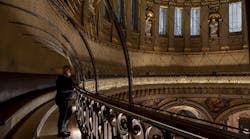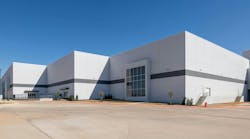Backed by more than 140 utilities and energy efficiency organizations, the Northwest Energy Efficiency Alliance (NEEA) serves energy consumers in the Northwest region by working to increase the adoption of energy-efficient technologies and practices by removing barriers to adoption and driving continuous improvement and advances up through the supply chain. Launched in 1999, The BetterBricks initiative by backed NEEA is a commercial program designed to further equip professionals in the building industry with resources to leverage energy efficiency programs and technologies to improve the built environment. Covering HVAC equipment to windows, lighting technology to energy management systems and more, BetterBricks educates the entire building community from designers through operators on how to optimize their business practices and buildings through energy efficiency measures.
As part of a BetterBricks educational series showcasing building experts' knowledge and experience in particular areas, Evergreen Consulting Group's Angela Pilant reached out to well-known lighting engineer and designer James Benya to discuss luminaire-level lighting controls (LLLC) — their benefits and how Benya approaches specification.
BetterBricks: How did you get into specifying and designing lighting systems, specifically controls?
James Benya: It started when I was in high school and college, when I was working in theatrical lighting. If you work in theater at all, you become really control centric. When I graduated from college as an electrical engineer, I decided to go into construction and immediately took a special interest in lighting controls and designing buildings. Professionally since, I’ve always considered the lighting control approach as an integral part of lighting design. Some of them were targeted at convenience, some were targeted at efficiency, some just aesthetics and livability. I am celebrating 50 years in this business, and among my many designs was the very first computerized central lighting control system used to control a big convention center in Tulsa, Oklahoma. I imagined it, specified it, and got a company to make it. My passion for smart and functional controls has been with me for a long time, and I’ve been very interested in the companies, the products that they’re making, the different ways to use lighting controls, and their various applications.
BetterBricks: What do you like about LLLC?
Benya: What makes LLLC such an important innovation is that it is cost-effective — you can save on labor, materials, and simple maintenance. Those are big deals, often more than the control devices themselves. For someone trying to maintain a building, it’s energy-efficient, it provides the right amount of light and only when it’s needed, and it’s easy to install. You pop in the luminaire, you hook up power to it, and you’re done.
BetterBricks: What are the advantages of LLLC over other lighting solutions?
Benya: I think the simplicity of LLLC is its calling card. You come to realize that what we need to optimize is the maintainability, long-term reliability, and low cost of maintenance. LLLC eliminates the hidden cost and complexity of programming every device and making complex control systems operate. In so many ways, LLLC is practically perfect.
BetterBricks: How has LLLC become a solution to address typical challenges with networked controls?
Benya: The biggest concern that I’ve had for the last 20 years using network lighting controls is that they won’t be wired correctly and/or properly programmed into the control system. However, LLLC is the essence of simplicity. You connect power to the luminaire, flip the switch, and it works. You can’t do anything easier than that.
BetterBricks: What’s the best way you’ve found to source control ideas when specifying a wireless lighting project?
Benya: Go to the manufacturer’s representatives and tell them what you want. Work with them. They are going to be the most knowledgeable people in the specifying process, and in some cases, they will bring in a manufacturer’s engineer to help. Also, go to trade shows — even small events — and your local utility company for resources like online seminars. There is a tremendous amount of information out there and people who are willing to share it with you.
BetterBricks: What else should professionals consider when choosing an LLLC or NLC system?
Benya: Is the software going to work in 10 years? Will someone be able to service it? I’ve had a couple of companies say, “We don’t service that product anymore. We want you to buy a new system.” I don’t specify those companies anymore. The good lighting companies train the agencies to install and service the systems. They have all the information about the project, including the programming that went into it. If needed, they send the agency out to look at the problem and fix it onsite. They only send somebody out from the factory if it’s a major problem.
BetterBricks: What are the best spaces for considering LLLC and why?
Benya: LLLC is a terrific idea for all kinds of office environments and meeting rooms. Healthcare and clinical settings are also good places for these systems. There are just so many spaces where the simplicity of LLLC — and the fact that they work really well — is a huge advantage.
BetterBricks: What’s a notable project you’ve done that incorporated LLLC?
Benya: Deborah Burnett, co-principal of the Benya Burnett Consultancy, and I won an IES International Illumination Design Award of Excellence for the only building that was ever certified as LEED Platinum and WELL Platinum. The WELL Building Standard is a vehicle for buildings and organizations to deliver more thoughtful and intentional spaces that enhance human health and wellbeing. LLLC was the perfect solution for the private offices and small meeting rooms. With LLLC, we used color temperature-changing technology to make sure the building occupants get the right amount and spectrum of light at the appropriate times of the day.
BetterBricks: What else do you want to share about LLLC?
Benya: We need to remember that everybody has different light needs and ensure we’re adjusting our lighting specifications to support people. LLLC already accommodates this new approach to human wellness in buildings because daylight sensors are fully incorporated, and I look forward to the industry recognizing this more. We know some people are night owls, and some are day owls. With LLLC and the right components and a couple of extra wires, we can ensure that the right amount and spectrum of light will be there for people right when they need it — regardless of their internal clock or assigned work schedule.
BetterBricks: What other advice you would give to specifiers thinking about implementing LLLC?
Benya: LLLC is a rational control system because it does the one thing that network lighting control systems don’t: It stands by itself. Just one unit can take an area and properly control the lighting with its occupancy and ambient light sensors — that makes it well-suited for offices, restrooms, and any space that has periodic occupancy and daylight. Also, it comes with big advantages like low cost and simple maintenance. That is a big deal for those who own and manage buildings.
Get additional insights from Benya in a short YouTube video from BetterBricks. For more energy-efficiency resources and an expert knowledge base, visit BetterBricks.
Content developed on behalf of and provided by BetterBricks, a commercial resource under the Northwest Energy Efficiency Alliance.
ANGELA PILANT has more than 25 years of experience working within the lighting and energy industries. She has a diverse background working as a utility specialist, manufacturer’s representative, and as a consultant, working side by side with customers to upgrade their facilities with energy efficient technology. She has worked at Evergreen Consulting Group since 2009 and specializes in market and trend analysis, utility program development, client engagement strategies, and training. Pilant is a certified instructor for the Building Operator Certification Program (BOC) and has developed and conducted cross-industry curriculum, including sales training, throughout the country. She has earned a Lighting Certified Professional designation from the National Council on Qualifications for the Lighting Professions (NCQLP).
Follow our LinkedIn page for our latest news updates, contributed articles, and commentary, and our Facebook page for events announcements and more. You can also find us on Twitter.






